How Wide Should Garden Beds Be Long Narrow
Vegetable gardening in small spaces can be a challenge. My answer to this problem is to build a concrete block planter to use as a raised bed vegetable garden .
Concrete blocks are inexpensive and making a raised bed with them is an easy project that can be accomplished in just a few hours.
This year, my husband and I built two of these planters for one area of our garden, and we are growing a complete vegetable garden in them.
I have used concrete blocks in the past to build a raised garden bed for flowers, and also made a fun cement block plant shelf for succulents. Now, I want to use them to make a concrete block raised bed for vegetables.

I've also used a combination of wood and cement wall supports to make an easy raised garden bed in just two hours!
In the past, I have had a 1000 sq. foot vegetable garden that the squirrels invaded, a mixed perennial and vegetable garden and a vegetable garden on a deck.
Each had their own pros and cons, but this year's small space raised vegetable garden is one of my most successful gardens yet.
Cement block planters are easy to tend, weed and water. They also yield a prolific harvest. Read on to find out how I built this vegetable garden.
As an Amazon Associate I earn from qualifying purchases. Some of the links below are affiliate links. I earn a small commission, at no extra cost to you, if you purchase through one of those links.
Are Concrete Blocks Safe for Vegetable Gardens?
There is some thought that some of the materials in concrete blocks or cinder blocks can leach into the soil. Some concrete blocks contain fly ash, which is a byproduct of burning coal.
This means that the blocks could contain heavy metals and other hazardous waste materials.
Concrete blocks can also contain lime, which might leach into the soil when you water your plants, but this is not thought to be harmful to humans.
So is it safe to use concrete blocks in gardens that will grow edible foods?
There have not been studies on this topic so it is hard to give a definitive answer to the question.
The University of Maryland Extension says that "cement block, cinder block and concrete block are made with cement and fine aggregates such as sand or small stones. Fly ash is also often included."
They also state that the choice of whether to use them for raised beds is personal and suggest that if this is a concern, then sealing the blocks with polymer paint is a good idea.
A concrete block sealer can also be used since this provides a waterproof seal to the blocks.
I chose to err on the side of caution and used a sealer for the blocks just to make sure that the vegetables are safe for us to eat.
Why use raised beds for vegetable gardening?
There are many benefits to gardening in raised beds. They make tending and harvesting vegetables a breeze because of their height.
Raised garden beds have less of a problem with weeds. If these do grow, they are easier to remove. Since the area of soil is less in raised beds, weeds don't have a chance to take root as readily as they do in larger areas of soil.
Since the soil in elevated gardening beds does not get compacted from walking on it, this allows roots to grow more easily.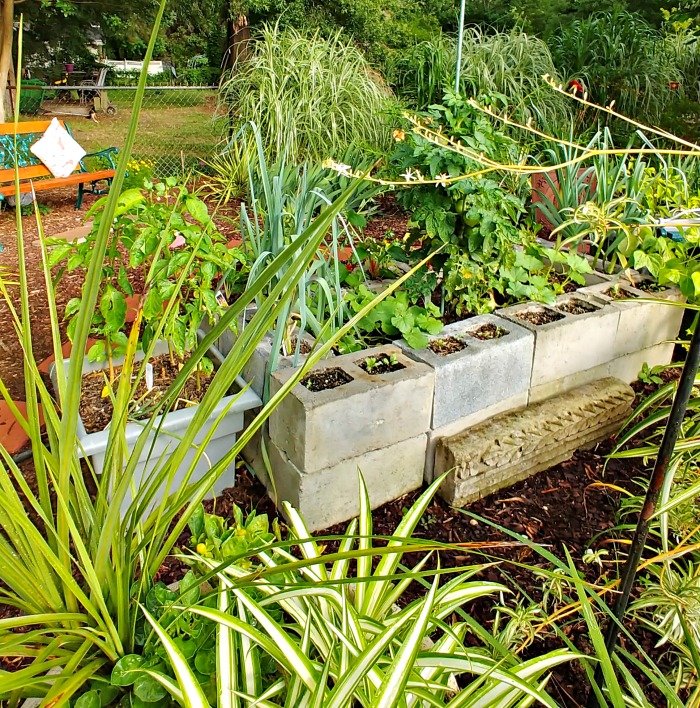
There are many other advantages to elevated beds. See additional tips and a pro/con list for a raised garden bed here.
Raised beds fit into a small space gardening plans. They make use of every square foot of gardening space you have available
How many concrete blocks do you need for a raised bed vegetable garden?
The answer depends on whether you are planning to use one or two horizontal rows of blocks on the sides.
Using two rows will require more soil but makes the bed easier to weed, tend and harvest. I made my concrete block planters this way and put together two of them.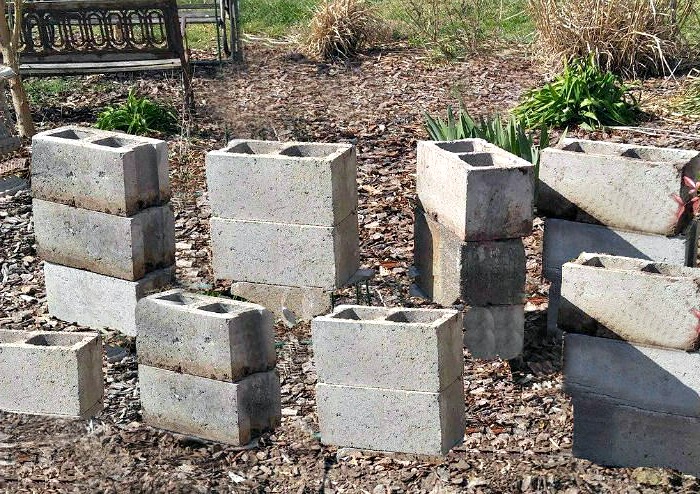
My concrete blocks measured 15 inches long. The sides of my planters had double rows of four blocks (16 blocks) and the ends used a pair of blocks on top of each other (4 blocks.) This made a total of 20 blocks for each planter.
My beds measured 60 inches long and 30 inches wide when they were done.
Concrete blocks are relatively cheap to buy, which means you will end up with an inexpensive raised garden bed. Let's start building one!
Recycling is a great way to turn something headed for the trash into a usable garden item. Find out how I used concrete blocks to made a raised garden bed for vegetables at The Gardening Cook. 🍎🍅🌶🥒🥬🥦🥕 Click To Tweet
Building a Raised Garden Bed Vegetable Garden
My small space gardening plan uses two large cement block raised planters, surrounded by more large individual planters. This allows me to grow an entire season of vegetables in a very small area.
To make sure the base of your concrete block planter is level, rake the area first.
Lay 4 concrete blocks in a row and check to make sure the row is reasonably level. If not, add more soil under the blocks to get them even. Once this is done, add a second layer of blocks on top of the first row.
Make the ends of the planter by placing a single block, facing in an alternating direction, and adding another on top of it.
The back of the planter is made the same way as the front. It is composed of two rows of four blocks. When you are done, you will end up with a long rectangular box.
Seal the blocks with the concrete block sealer, or polymer paint, by brushing it on the inside areas of the top row of blocks along the edges. Then, seal the whole inside section of the main area of the planter. Allow the sealer to dry completely.
An optional step is to also seal the outside of the planter. This will help to keep the soil from drying out as quickly.
Fill the center section of the concrete block planter and add soil to each of the small sections around the edge of each raised bed planter.
Adding Soil to the Concrete Raised Beds
You can certainly buy soil and fill up the raised beds, but since there is a lot of area to fill and this could get quite expensive.
The best soil for raised beds is a mixture of about 60% topsoil, 30% compost and 10% good quality potting soil. This will save money but still give you a great soil for growing the vegetables.
I filled the lower portion of the planter sections with top soil. Then I added a good helping of compost and topped each bed with Miracle Gro garden soil.
Best Vegetables to Grow in Raised Beds
Now comes the fun part – planting the vegetables!
When choosing vegetables for raised garden beds, the most important thing to keep in mind is the size of each section in the planter. Some of the sections are perfect for large plants. Others, normally along the edges, are better for more compact plants.
Read on to find out how I placed my vegetables in the concrete raised garden beds.
Large Center Sections of the Concrete Blocks Planter
The larger center section is perfect for both larger plants and those that have a tendency to crawl along the soil. This area has a lot of soil that allows the roots to grow deeply and also gives the perfect area for plants that need more room.
I planted determinate tomatoes and cantaloupe melons in one my center sections.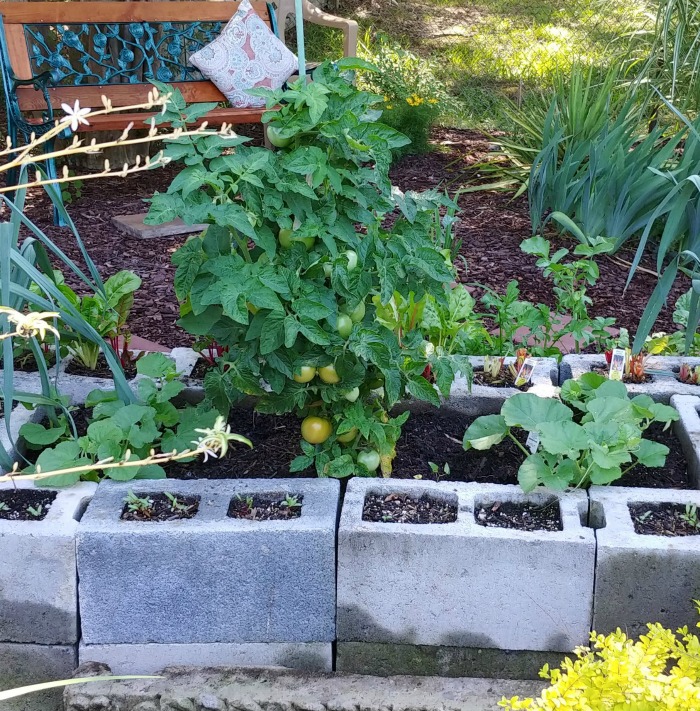
The other planter has indeterminate tomatoes planted with cucumbers under them. (In North Carolina, cucumbers can sizzle in the summer heat, and turn yellow prematurely, so the tomatoes give them some shade.)
The heat also can make tomatoes stop ripening. Find out why this happens and some tips for ripening tomatoes on the vine.
Smaller Side Planter Areas of the Raised Bed
The small areas along the edge of the raised vegetable garden bed hold plants with a small crown that are upright and will not spread too much. These areas hold individual plants of all types.
When the summer started, I planted spinach, kale, Romaine, and leaf lettuce in these areas. These are plants that love the cool weather but will bolt and turn bitter when the summer heat arrives.
I also have Swiss chard growing in the side sections and have been harvesting it for recipes all spring. It can tolerate warm (but not hot) weather, so it still has a bit of time left to grow.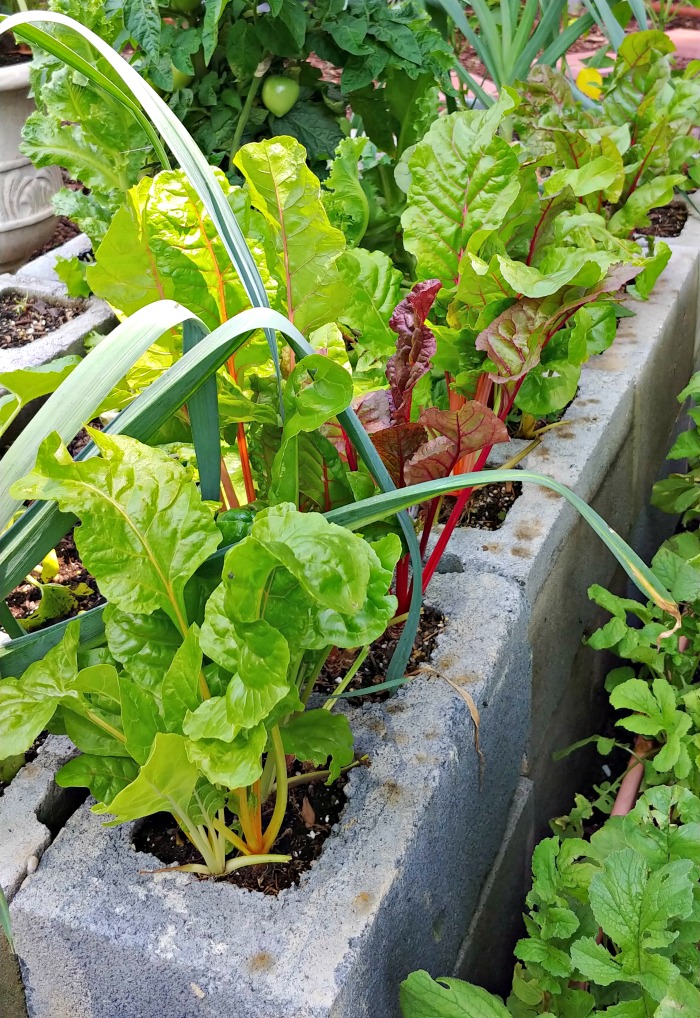
The beauty of these smaller side areas is that once a plant is done for the season, it's super easy to replace it with another variety.
Once the cold weather plants are harvested, it will be time to plant beans, and beets in the same sections.

Leeks are an example of a plant that does very well in the small sections of a raised garden bed. They are plump and almost ready to harvest. Because of their narrow root area, I can plant two leeks in each of the concrete block openings.
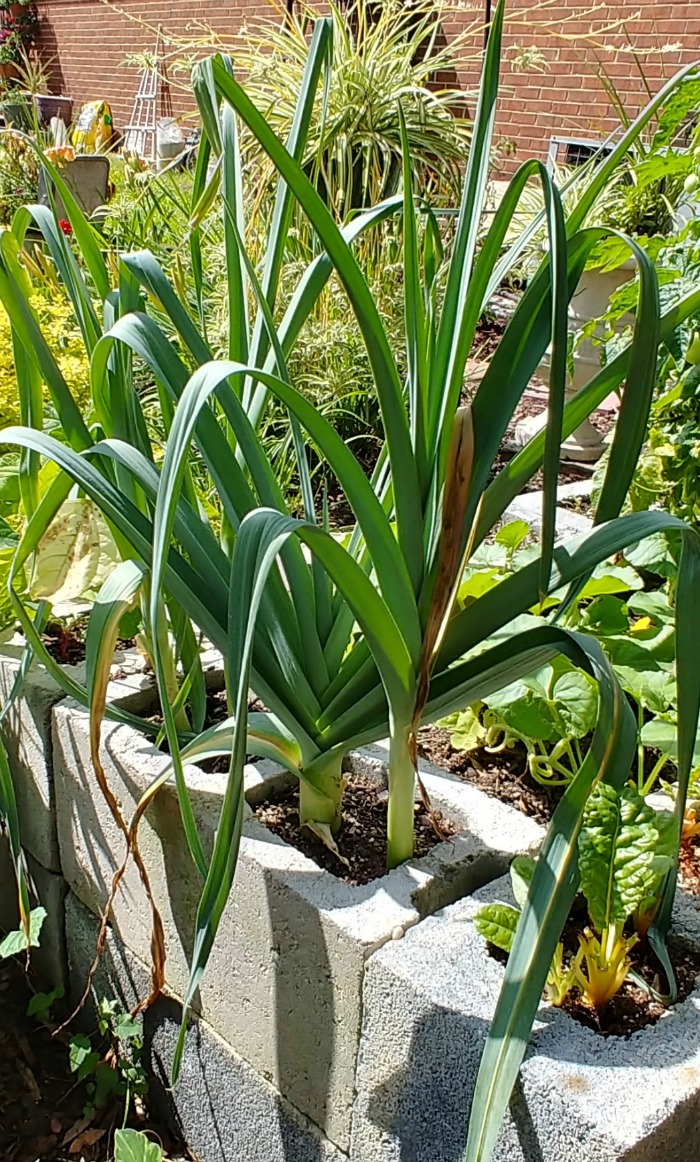
I'm currently waiting for the leeks in the top section to grow large enough to harvest. Leeks are a cut and come again vegetable, and after I harvest them, I will to allow the root area to re-grow."
My biggest surprise has been how successfully my broccoli is growing in these small sections. The plants are huge! I have been harvesting them for about a month and they are still going strong.
Growing Vegetables in Containers around the Elevated Garden Bed
We eat a lot of vegetables at our house, and I wanted to grow even more. However, I had only allotted a small amount of space to my vegetable garden.
In addition to the raised vegetable beds, I surrounded my concrete block planters with large containers to hold even more vegetables. This allowed me to keep to the spirit of small space gardening but increased my output of vegetables.
The end of each raised vegetable garden bed features a 16 inch planter containing pepper plants. Two more large planters sit behind the center of the two beds, and they hold spicy banana peppers.
To make better use of my planter area, I under-planted the sweet peppers with onions. These two make good companion plants and fit into gardening plan for a small space.
Cucumbers have always been a challenging vegetable for me to grow. This year, I have them growing in a large planter on the back section of the raised bed. I added wire sections on both sides for the cucumber vines to climb.
Cucumbers love to spread out, but this does not have to mean growing along the ground. Giving them with a support on which to climb works well for me. Fingers crossed that they keep growing well!
Two large pots take up the space behind one of the cement block planters. y great grandmother's heirloom pole beans are planted in these containers. A DIY bean teepee gives the vines space to climb.
The teepee is made with tomato poles and is extremely easy to assemble. Get directions for the DIY bean teepee here.
The back of the second planter has a long narrow planter which is full of radishes. These should be ready to harvest any day now.
Watering the Raised Bed Vegetable Garden
I water the vegetable garden and surrounding flower garden once daily. I do this in the evening by means of an oscillating sprinkler.
The sprinkler sits on a small plant stand, raising it to about the height of the elevated garden beds. It is an effective way to water the garden.
A better solution for watering would bes oaker hoses that lay along the rows of the raised bed, but that is a project for another year.
I run the oscillating sprinkler for 20-30 minutes, on the days that we get no rain, and it waters an area of about 1000 square feet.
Combining Vegetables and Flowers
My concrete block raised vegetable garden bed sits in the middle of one of my largest flower gardens. I love that both gardens blend so cohesively together.
The flowers delight the onlooker, and the vegetables are there – quietly growing, just waiting for me to come out to harvest them. Even though I have a whole vegetable garden in the center of this bed, it doesn't look so "country vegetable garden," which appeals to me.
I also love that the sprinklers water the entire area. My flowers are amazing this year!

Pin This Concrete Blocks Planter Tutorial for Later
Would you like a reminder of this post for a raised bed vegetable garden? Pin this image to one of your gardening boards on Pinterest so that you can easily find it later. Admin note: This post first appeared on the blog in June of 2013. I have updated the post to add the tutorial, all new photos, a printable project card and a video for you to enjoy.
Admin note: This post first appeared on the blog in June of 2013. I have updated the post to add the tutorial, all new photos, a printable project card and a video for you to enjoy.
Active Time 4 hours
Total Time 4 hours
Difficulty easy
Estimated Cost $50
Materials
- 20 concrete blocks
- 5 bags of topsoil
- 3 bags of compost
- 1 large bag of good quality soil
- Concrete sealer or polymer paint
- Vegetable plants or seeds
Instructions
- Rake the area where you plan to have the raised bed sitting.
- Lay four blocks in a line and use a spirit level to make sure the row is even and level.
- Lay an additional four blocks on top. These two rows makes the front section.
- Place two blocks on each end of the row to make the sides of the planter.
- Repeat step 3 for the back section.
- Seal the inside of each of the small top holes and also the entire inside area of the center section to protect the vegetables from any harmful chemicals leaching out into the soil.
- Allow the sealer to dry completely according to the manufacturer's directions.
- OPTIONAL: If you wish, you can seal the entire outside of the planter. This will help to keep the soil from drying out as quickly as one that is not sealed.
- Fill the small holes and center section soil that is a mixture of 60% topsoil, 30% compost and 10% good quality garden soil.
- Plant small vegetable plants or seeds in the small sections along the edges.
- Plant the middle area with plants that are larger and like to roam.
- Enjoy!
Notes
Plants to choose for small sections:
Beets, leeks, spinach, lettuce, Swiss chard, broccoli, Brussels sprouts, etc.
Plants to choose for center section:
Tomatoes, Bush Beans, Cucumbers, Melons, Peas, Corn, etc.
NOTE: The cost of the planter depends on whether you choose to make it double sided or single sided rows of blocks. I also approximated on the soil costs depending on whether you had to purchase new potting soil, or have existing garden soil and compost that can be used.
Disclosure of Material Connection: Some of the links in the post above are "affiliate links." This means if you click on the link and purchase the item, I will receive a small commission from the sale, but the price is the same for you. I am disclosing this in accordance with the Federal Trade Commission's 16 CFR, Part 255: "Guides Concerning the Use of Endorsements and Testimonials in Advertising."
How Wide Should Garden Beds Be Long Narrow
Source: https://thegardeningcook.com/todays-vegetable-harvest-june-15/
Posted by: denneysoperypear.blogspot.com

0 Response to "How Wide Should Garden Beds Be Long Narrow"
Post a Comment